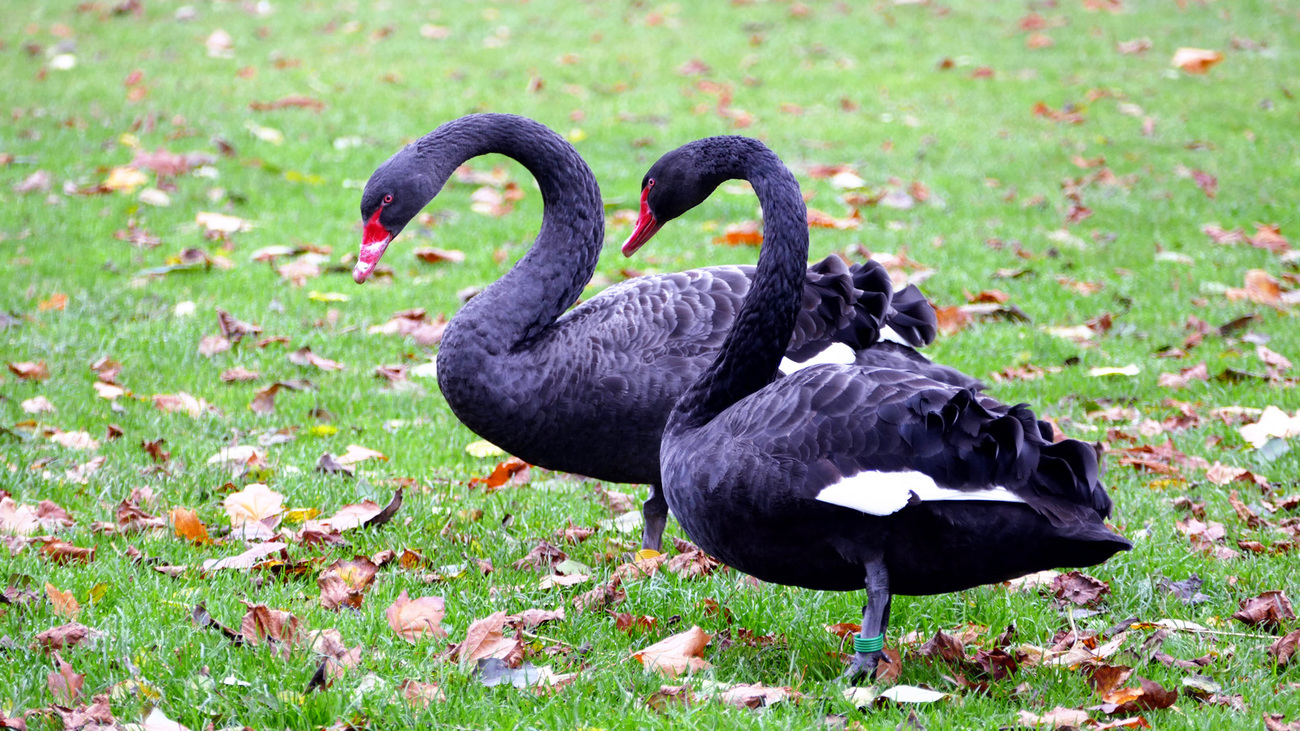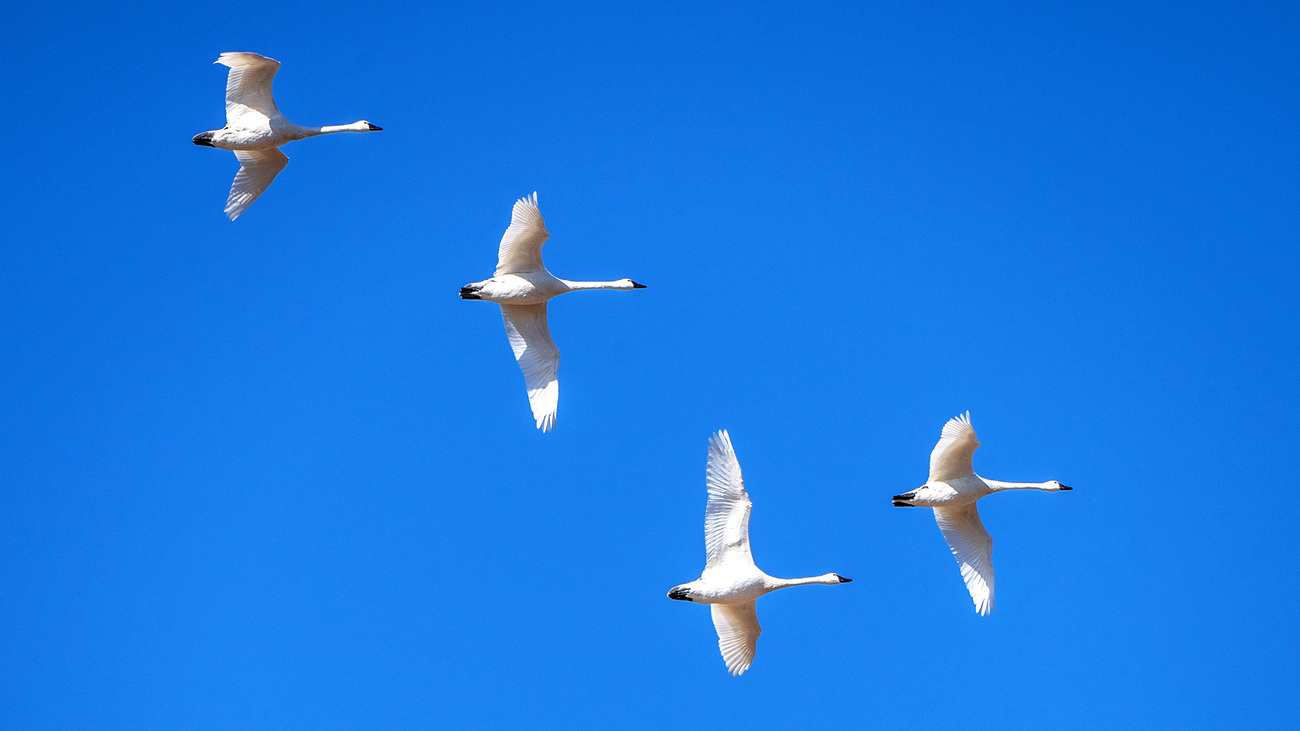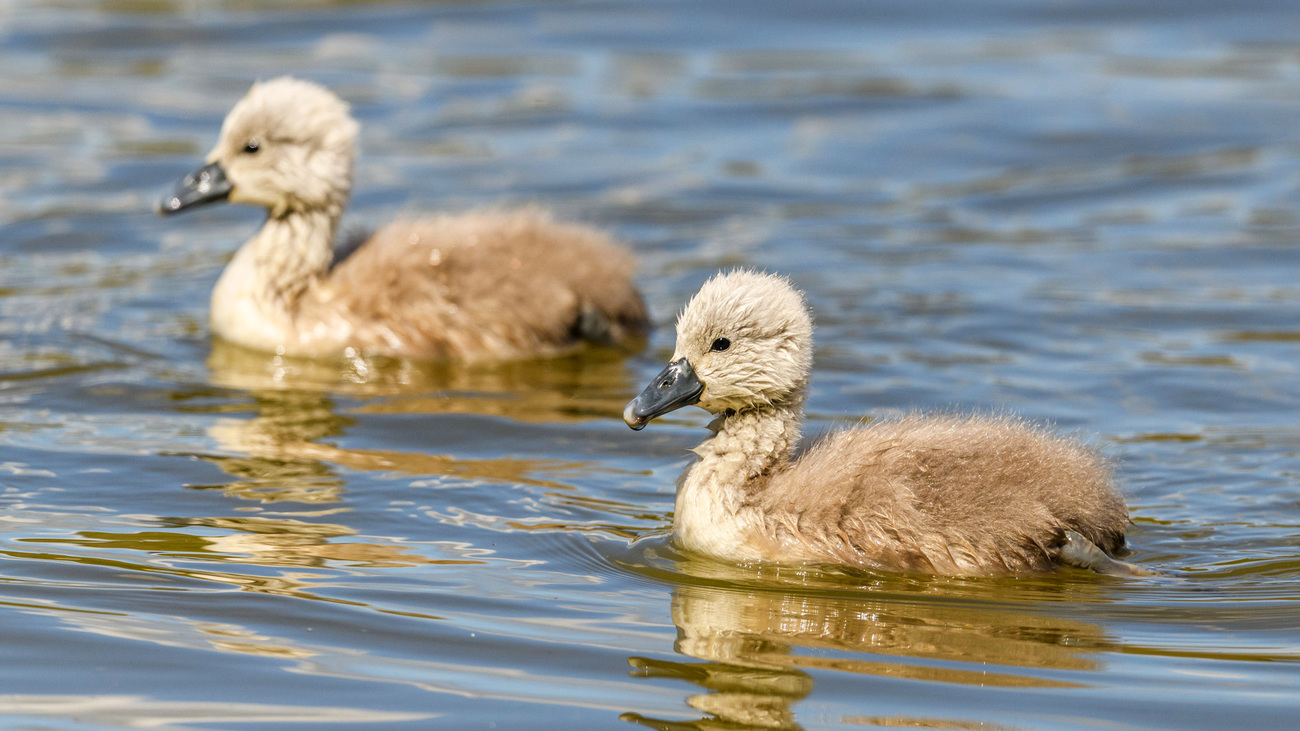Swans
What is a swan?
Swans are large waterfowl that are famously elegant and have long, slender necks. While the majority of swan species are white, black swans have black plumage, and the black-necked swan has a white body and a black head and neck. All baby swans—known as cygnets—are grey when they’re born.
There are six species of swan—mute, whooper, trumpeter, tundra, black, and black-necked. They are all members of the genus Cygnus. The coscoroba swan used to be part of the genus Cygnus but is now considered part of the genus Coscoroba.
Typically, these birds live in temperate climates in both the Northern and Southern Hemispheres, though different species of swans live in different habitats. They inhabit a variety of natural and manmade bodies of water, including freshwater lakes, ponds, rivers, canals, swamps, marshes, and coastal inlets. Swans are mainly herbivorous. They eat aquatic plants but sometimes also ingest small aquatic animals. As they paddle on the surface of the water, they use their long necks to reach the vegetation below.
Swans mate for life, and they perform an elaborate courtship dance to cement their bond. They typically breed during the spring or summer, with some species traveling to the Arctic in flocks to do so. They build huge nests at the edge of the water, where a female swan lays between three and eight eggs. Both parents take turns incubating the eggs. When hatched, cygnets stay with their parents for several months before joining a flock.
Swans play a vital role in maintaining the health of aquatic ecosystems. By eating plants and small aquatic animals, they help spread seeds and aquatic animal eggs through their feces, supporting the growth of plants and the survival of animal species. While swimming, they also stir up sediment, which helps circulate nutrients around these bodies of water, supporting the health of the plants and fish that live below.
What is a swan’s scientific name?
There are six species of swan in the genus Cygnus. One species of swan is no longer considered a true swan and is classified in the genus Coscoroba.
All swan species have unique scientific names:
- Whooper swan (Cygnus cygnus)
- Tundra swan (Cygnus columbianus)
- Mute swan (Cygnus color)
- Black swan (Cygnus atratus)
- Black-necked swan (Cygnus melancoryphus)
- Trumpeter swan (Cygnus buccinator)
- Coscoroba swan (Coscoroba coscoroba)
It’s worth noting that some scientists split the tundra swan into two species: Bewick’s swan (Cygnus bewickii), which lives in the Palearctic of Europe, Asia, and North Africa, and the whistling swan (Cygnus columbianus), which is native to the Nearctic of Greenland and North America.
Are swans endangered?
All species of swans are categorized as least concern by the IUCN and have either stable or increasing populations. The tundra swan was hunted almost to extinction, but its numbers have now recovered.
Nevertheless, despite their healthy numbers, all swan species face challenges, including habitat loss, pollution, and avian flu.
Where do swans live?
Swans tend to live in lowland, freshwater wetlands. You can find them in shallow lakes, ponds, lagoons, marshes, reed beds, and slow-flowing rivers. You can also find them on artificial bodies of water, like reservoirs, gravel pits, ornamental lakes, and canals. Some swans venture into brackish and saltwater habitats too.
Different swan species live in different parts of the world. The mute swan, trumpeter swan, whooper swan, and tundra swan live in the Northern Hemisphere. The black swan, the black-necked swan, and the coscoroba swan live in the Southern Hemisphere. Specifically, you’ll find black swans in Australia and black-necked and coscoroba swans in South America.
All swans live in temperate climates and are rarely found in the tropics. Most species of swan migrate. They travel to find food when temperatures drop and their habitat freezes. But they don’t always migrate if the winter is mild. Some species travel to the Arctic during the breeding season.
Threats
All swan species are categorized as the least concern and have stable or growing numbers. However, there are still threats to their survival and well-being. Habitat loss, pollution, the actions of hunters, and avian flu all pose a risk to swan species.

Habitat degradation and loss
Human activities, including drainage, oil pollution, and peat extraction, are damaging and reducing the size of swans’ natural habitats. The swan’s Arctic breeding grounds are also threatened by climate change, as well as oil and gas exploration, making it harder for the birds to lay and incubate their eggs.
As human settlements expand, so too do the power lines used by locals. As these are often erected across swans’ migration routes, the risk of collisions increases, causing more and more injuries and deaths.
Pollution
Water pollution is another large threat to swans, as it negatively affects their habitats. Industrial waste, agricultural runoff, sewage, plastic waste, and oil are entering bodies of water where swans live, impacting everything from water quality to swan health to food availability.
Hunting
In some US states, swans are hunted for sport, while in other areas, swans are hunted illegally despite the protections in place. Even when swans aren’t directly targeted, they can be affected by hunting activities. They are increasingly susceptible to lead poisoning due to lead ammunition, fishing tackle, and discarded fishing weights.
Avian flu
Swans are susceptible to avian influenza, which can be deadly. Avian flu has been documented in birds since 1878, but there have been particularly bad recent outbreaks since 2020.
FAQs
Do swans mate for life?
Yes, swans mate for life. Trumpeter swans can form monogamous pair bonds from the age of 20 months, even though they don’t breed until they reach four to seven years old. Swans perform a graceful mating dance. They dip their heads into the water, then raise and ruffle their feathers while moving their necks in unison.
The female swan (called a pen) lays between three and eight eggs in a large nest. Both she and the male swan (called a cob) take turns incubating the eggs, a process which takes 35 to 41 days.
Swans are generally sociable animals and they like to spend time in flocks. However, during the breeding season, they can become territorial and aggressive.
Can swans fly?
Yes. Swans are strong flyers. They fly faster than any other waterfowl, and they’re as graceful in the air as they are in the water. When they migrate, swans fly in a diagonal line or a V-formation. They take turns to lead the flock.
Whooper swans can fly non-stop for 1,600 kilometres (1,000 miles) and swans can reach heights of 1,800 to 2,400 metres (6,000 to 8,000 feet). They travel at an average speed of 32 to 48 kilometres per hour (20 to 30 miles per hour) and some species have been recorded travelling at speeds of 96 kilometres per hour (60 miles per hour).
Most young swans can take their first flight once they are 12 weeks old. However, it takes a little more time for them to develop the strength and flight feathers they need to fly longer distances.

What do swans eat?
Swans tend to eat aquatic plants, like pondweed in freshwater and sea arrowgrass in saltwater. They are primarily herbivorous, with plants making up the majority of their diet. However, they also ingest small aquatic animals like fish, insects, and invertebrates.
Swans feed by ‘dabbling’, meaning they stay on the surface of the water and don’t dive down for their food. Instead, they use their powerful beaks to pull up underwater plants. They can also graze on land.
What is a baby swan called?
A baby swan is called a cygnet. Baby swans have short necks and thick grey downs, with greyish to black beaks and feet. Cygnets can run and swim just a few hours after hatching, though their parents are very protective of them for the first few months of their life. In some species, cygnets even ride on their mother’s back.
After four to 12 months, baby swans are ready to leave their parents. At this point, the juvenile birds have grey or brown plumage. By the time a young swan is around two years old, their feathers will turn white or black, depending on the species.
Do swans migrate?
Yes, swans migrate, but their migratory behaviour varies depending on their species, location, and the availability of food. Swans can tolerate cold temperatures, so they usually travel in search of food, rather than shelter. If their usual habitat freezes over in the winter, they’re unlikely to stay put.
Some mute swans stay in their usual habitat all year round as long as there is a good food supply. They may travel a short distance to form winter flocks in nearby lakes and rivers. In the UK, most resident mute swans stay within 96 kilometers (60 miles) of the place where they were born. However, migratory mute swans in Europe may migrate to spend the winter in North Africa, India, or the Middle East.
In North America, trumpeter and tundra swans tend to migrate south from Canada and Alaska into warmer parts of the continent. The whooper swan migrates from Scandinavia, Iceland, and Russia to warmer countries in Europe. Black swans and black-necked swans don’t migrate, but they do live nomadically. They travel around in search of better wetlands and a good food supply.
Most swans return from their wintering grounds in time for spring. They return to their breeding grounds before March or April and spend the summer there.
Do swans have teeth?
No, swans don’t have teeth. They have a strong beak with a serrated edge. This keeps their bodies light so they use less energy when flying.
To break down their food, they have a ‘gizzard’, a muscular organ common to all birds. The gizzard crushes food so it can be digested, essentially performing the same function as molar teeth in mammals.
How big are swans?
The size of a swan varies depending on its species.
The coscoroba swan is the smallest and is about one meter (3.3 feet) long. The trumpeter swan is the largest and is around 1.7 meters (5.5 feet) long. It also has a 3-meter (10-foot) wingspan.
Despite being the largest, the trumpeter swan isn’t the heaviest swan species. That award goes to the mute swan, which weighs 23 kilograms (50 pounds) and is one of the heaviest flying birds in the world.
How long do swans live?
Swans reach maturity after three or four years. This is when they tend to start breeding. They can live for around 20 years in the wild and 50 years or more in captivity.
Our work
IFAW worked with partners in Ukraine to rescue animals affected by the war. We supported the Swan Shelter in Mezhyhirya, which is in the Kyiv region. The shelter rehabilitates wild birds rescued from war-torn areas and releases them back into their natural habitats. IFAW allocated emergency funds to the Swan Shelter, which enabled the team to buy food and feeding buckets and repair swan enclosures.
We also supported the Bird Shelter in Niushannikovo, where 12 young swans were rescued and rehabilitated. With our help, these bird sanctuaries are managing to release swans back into the wild, despite the ongoing conflict.

How can you help?
Swans are vital to their ecosystems, and though they aren’t currently endangered, they face significant threats in many parts of their range. IFAW is working to protect swans and other wildlife around the world.
